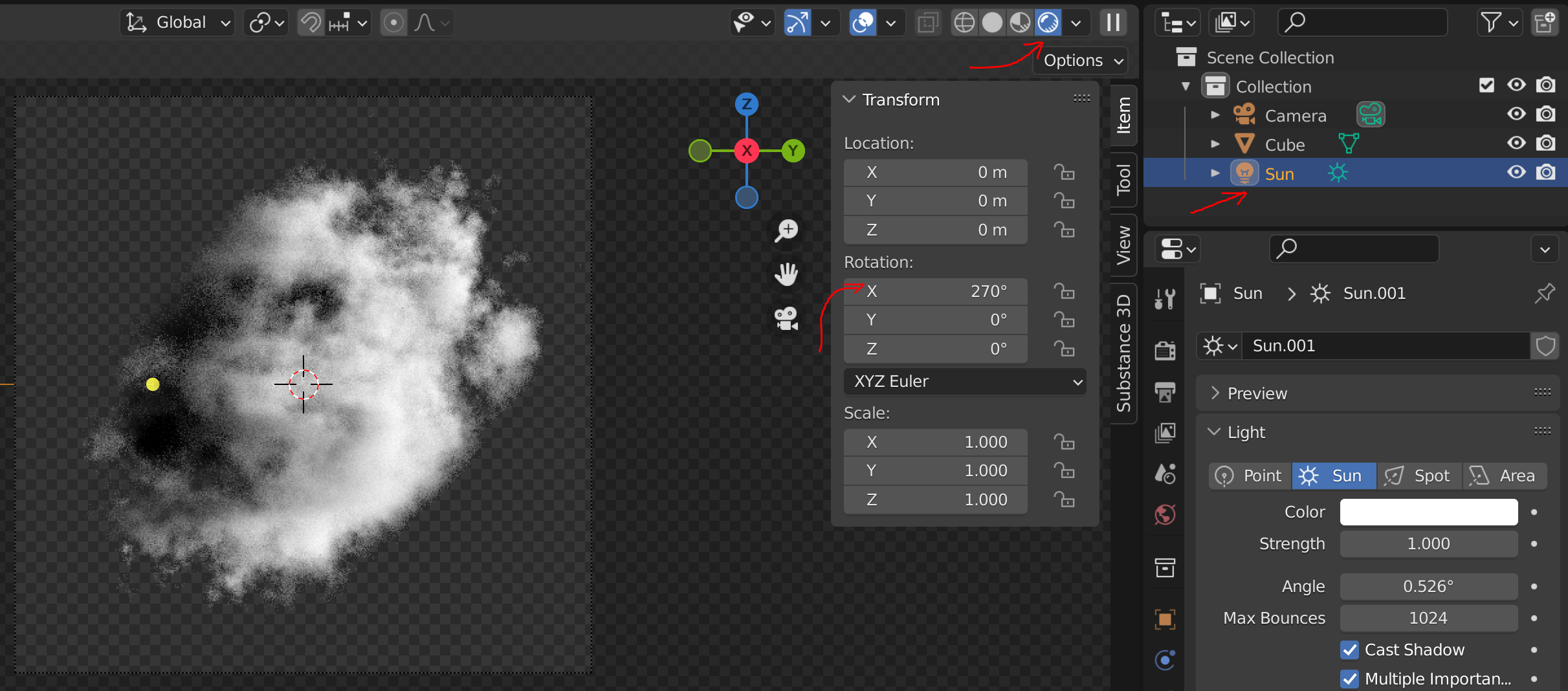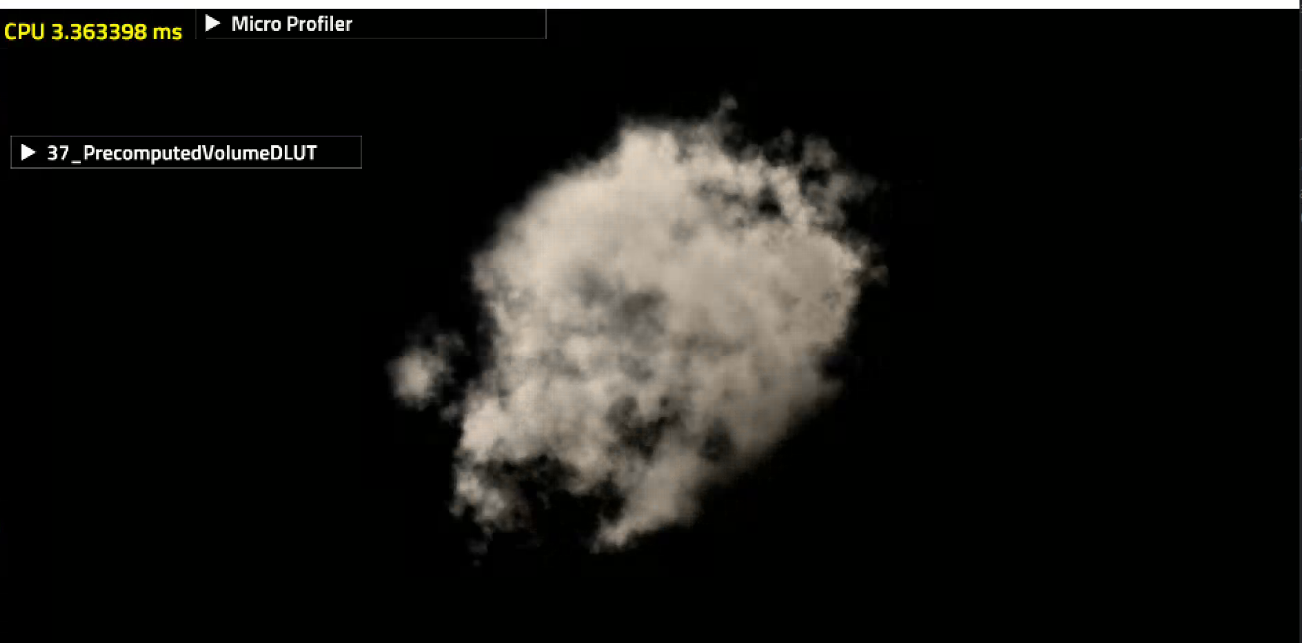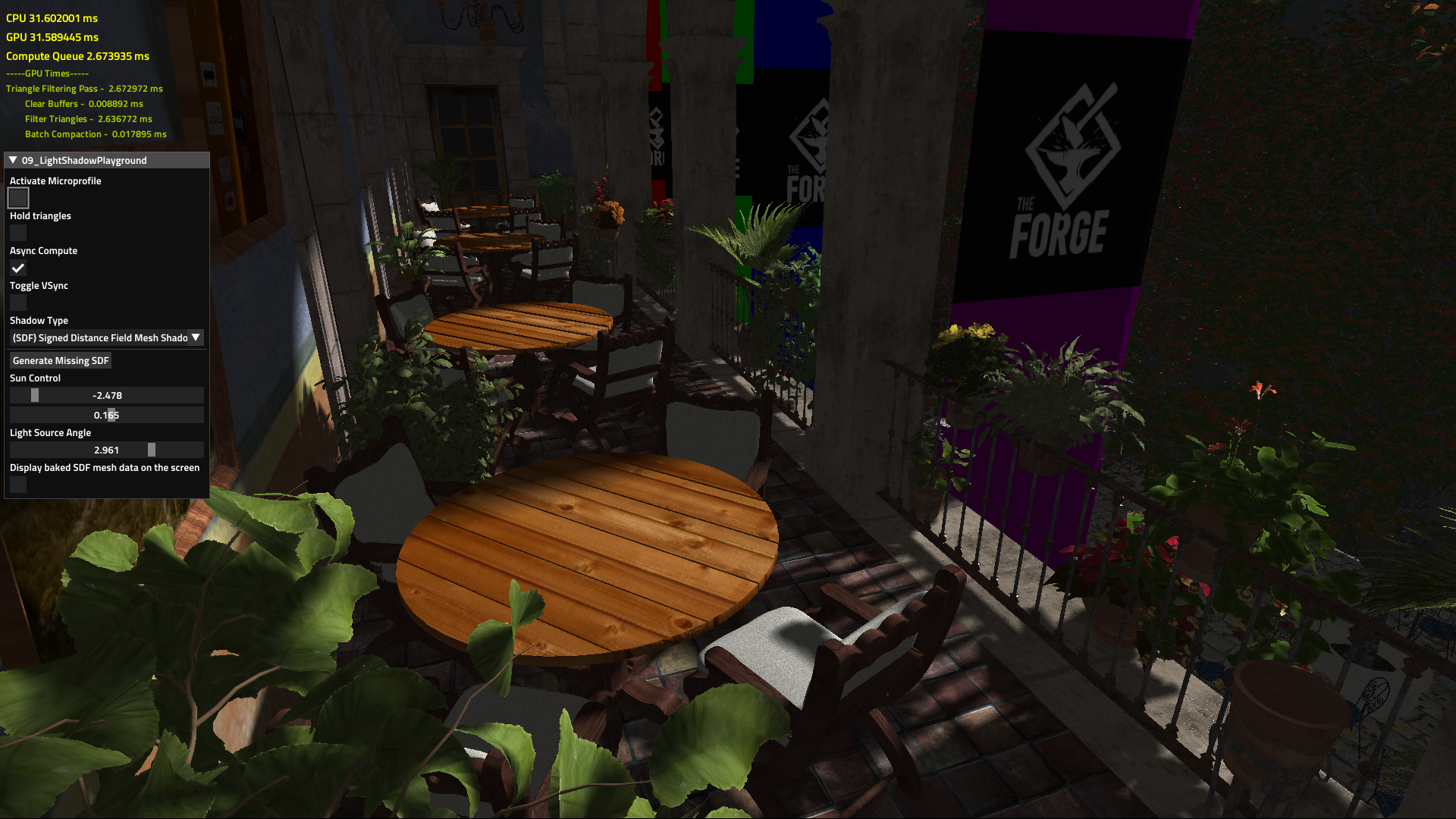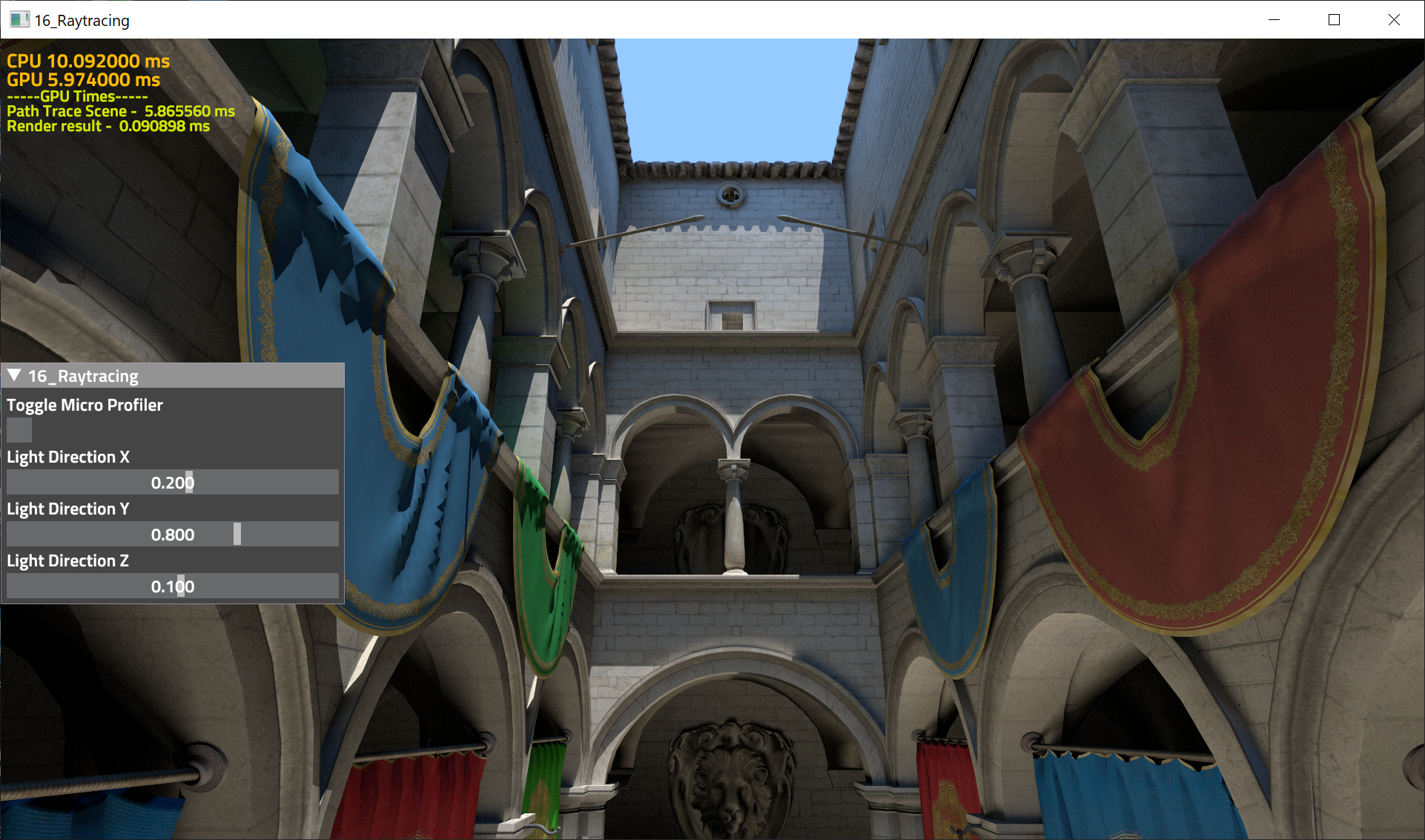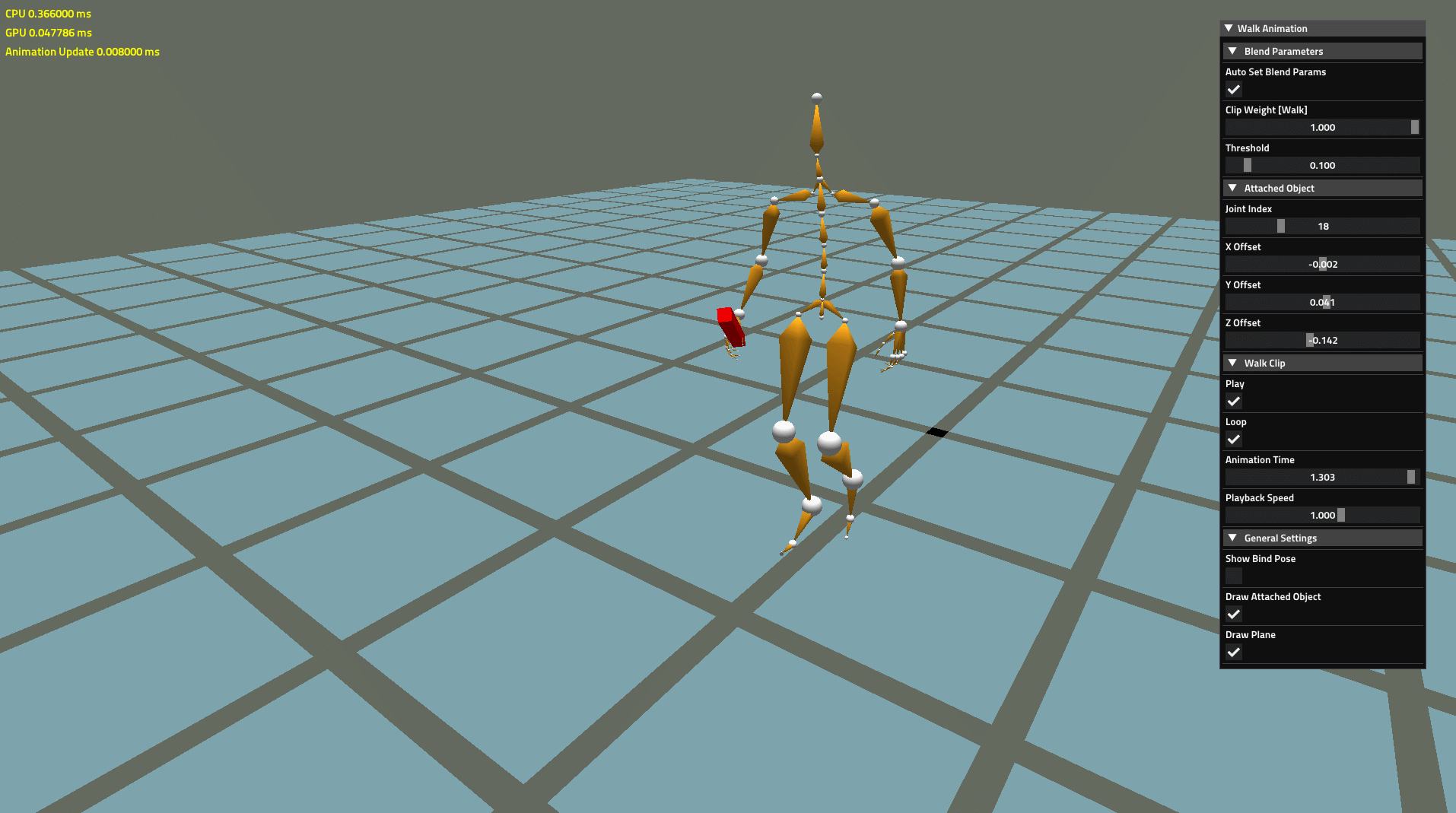The Forge is a cross-platform rendering framework supporting
- PC
- Windows 10
- with DirectX 12 / Vulkan 1.1
- with DirectX Ray Tracing API
- DirectX 11 Fallback Layer for older Windows paltforms
- Linux Ubuntu 18.04 LTS with Vulkan 1.1 and RTX Ray Tracing API
- Windows 10
- Android Pie or higher with
- Vulkan 1.1
- OpenGL ES 2.0 fallback for large scale business application frameworks
- macOS / iOS / iPad OS with Metal 2.2, Intel and Apple processor support
- Quest 2 using Vulkan 1.1
- XBOX One / XBOX One X / XBOX Series S/X *
- PS4 / PS4 Pro *
- PS5 *
- Switch using Vulkan 1.1 *
*(only available for accredited developers on request)
Particularly, the graphics layer of The Forge supports cross-platform
- Descriptor management. A description is on this Wikipage
- Multi-threaded and asynchronous resource loading
- Shader reflection
- Multi-threaded command buffer generation
The Forge can be used to provide the rendering layer for custom next-gen game engines. It is also meant to provide building blocks to write your own game engine. It is like a "lego" set that allows you to use pieces to build a game engine quickly. The "lego" High-Level Features supported on all platforms are at the moment:
- Resource Loader as shown in 10_PixelProjectedReflections, capable to load textures, buffers and geometry data asynchronously
- Lua Scripting System - currently used for automatic testing and in 06_Playground to load models and textures and animate the camera and in several other unit tests to cycle through the options they offer during automatic testing.
- Animation System based on Ozz Animation System
- Consistent Math Library based on an extended version of Vectormath with NEON intrinsics for mobile platforms. It also supports now Double precision.
- Extended version of EASTL
- Consistent Memory Managament:
- on GPU following Vulkan Memory Allocator and the D3D12 Memory Allocator
- on CPU Fluid Studios Memory Manager
- Input system with Gestures for Touch devices based on an extended version of gainput
- Fast Entity Component System based on flecs
- Cross-platform FileSystem C API, supporting disk-based files, memory streams, and files in zip archives
- UI system based on Dear imGui extended for touch input devices
- Shader Translator using a superset of HLSL as the shader language, called The Forge Shading Language. There is a Wiki page on The Forge Shading Language
- Various implementations of high-end Graphics Effects as shown in the unit tests below
Please find a link and credits for all open-source packages used at the end of this readme.
![]() Join the Discord channel at https://discord.gg/hJS54bz
Join the Discord channel at https://discord.gg/hJS54bz
![]() Join the channel at https://twitter.com/TheForge_FX?lang=en
Join the channel at https://twitter.com/TheForge_FX?lang=en
The Forge Interactive Inc. is a Khronos member
Build Status
News
Release 1.52 - April 29th, 2022 - C Code Hot Reloading Unit Test | Visibility Buffer OIT | Pre-Computed DLUT Test | Unified Window and Resolution control | Android Vulkan Validation Layer | CPU Features | Upgraded Vulkan and DX GPU allocator | macOS / iOS improvements | Double precision Math Library | Impoved Input System with HID support
We are always looking for more graphics / engine programmers. We are also specifically looking for a consultant who can help us to scale up our hardware testing environment.
The following list of changes is not fully representative of all the improvements we made, so it is just a selection:
- C Code Hot Reloading Unit Test - This unit test showcases an implementation of code hot reloading in C, we've used and adapted the following GitHub library
for this.
The test contains two projects:
- 19_CodeHotReload_Main: generates the executable. All code in this project can't be hot-reloaded. This is the project you should set as startup project when running the program form an IDE.
- 19a_CodeHotReload_Game: for development platforms Windows/MacOS/Linux generates a dynamic library that is loaded by the Main project in runtime, when the dynamic library changes the Main program reloads the new code. For Android/IOS/Quest/Consoles this project is compiled and linked statically.
How to use it: While the Main project is running open 19_CodeHotReload_Game.cpp and perform some change, there are lines marked with TRY_CODE_RELOAD to make easy changes. Once the file is saved, you can rebuild the project and see the changes happen automatically.
- Windows/Linux: Click on the UI "RebuildGame" button.
- MacOS: Command+B on XCode to rebuild.
Note: In this implementation we can't call any functions from The Forge from the HotReloadable project (19a_CodeHotReload_Game), this is because we are compiling OS and Renderer as static libraries and linking them directly to the exe. Ideally these projects should be compiled as dynamic libraries in order to expose their functionality to the exe and hot reloadable dll. The reason we didn't implement it in this way is because all our other projects are already setup to use static libraries.
- Visibility Buffer Order-Independent Transparency - we added OIT by utilizing a per-pixel linked list to a Visibility Buffer (VB) rendering architecture. In case of Deferred Shading (DS), the per-pixel linked list holds per-pixel data. In case of VB it only holds the triangle index data. You can switch between DS and VB in this example. The VB version occupies substantially less memory and is faster. With memory bandwidth being the biggest challenge in graphics programming, this is not unexpected. Most people by now adopted the idea of VB in one or two ways but it doesn't hurt to show another advantage of the architecture.
XBOX One (original) 1080p resolution
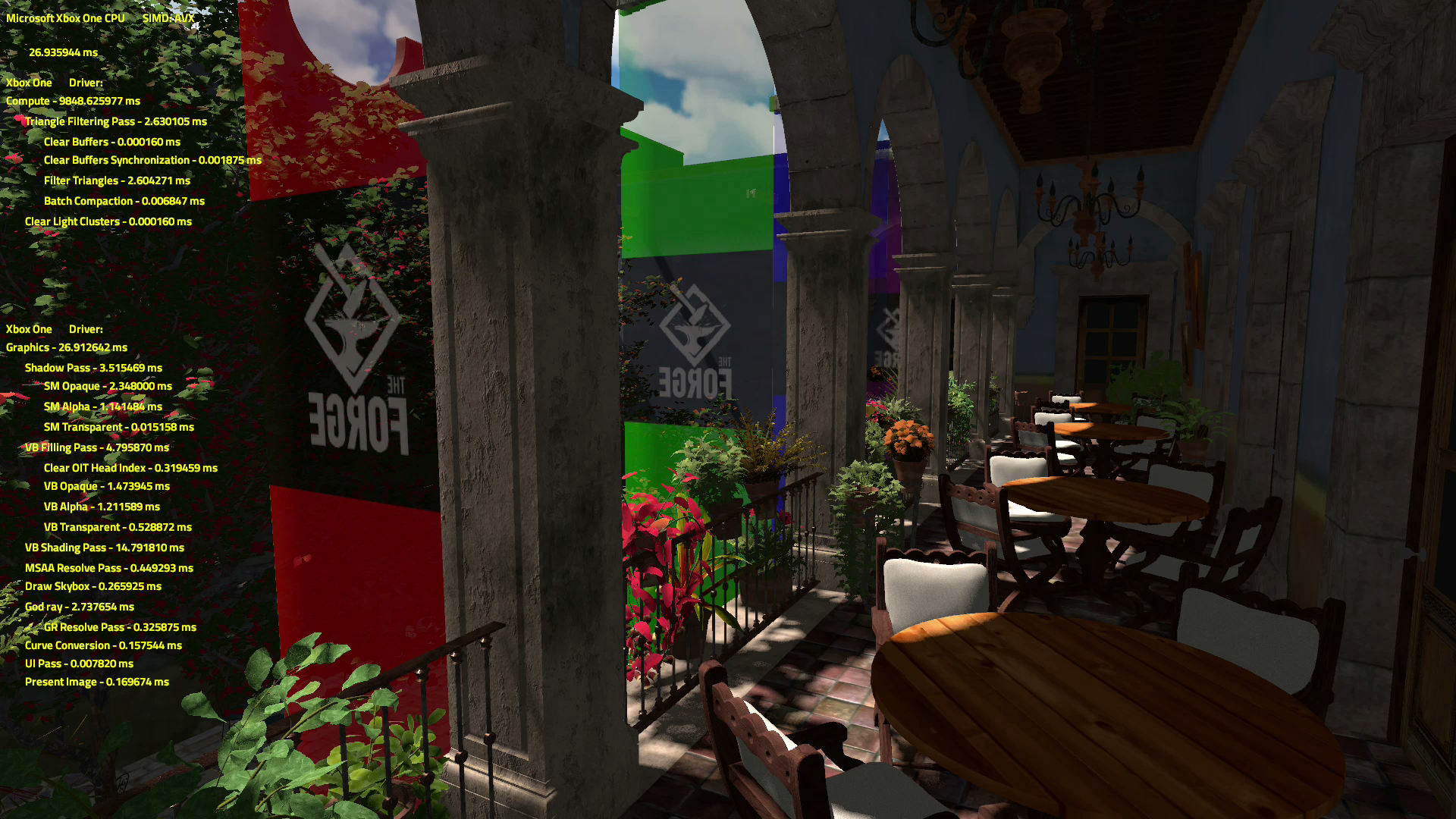
- Pre-Computed DLUT Test - this test implements pre-computing volume transmittance in Blender or Houdini for 6 directions and shading clouds/smoke based on the following tweets:
https://twitter.com/Vuthric/status/1286796950214307840
A detailed description can be found here: https://realtimevfx.com/t/smoke-lighting-and-texture-re-usability-in-skull-bones/5339
In this repository is a "dlut.blend" file that contains a minimal volumetric render setup. In order to generate DLUT image do the following steps:
- Set the viewport shading to "Rendered"
- Select the "Sun" object
- Set the X rotation to 0 degrees
- Press F12 to render the image and wait for a few minutes until it's done
- Save the rendered image to "dlut_0.png"
- Repeat steps 3-5 for 90, 180 and 270 degrees and save "dlut_90.png", "dlut_180.png" and "dlut_270.png"
- Run the "combine_dlut.py" Python script or manually combine rendered images in your image editor of choice, each color channel should contain the red channel from the corresponding "dlut_*.png" image multiplied by the alpha channel of the same image. For example, green channel should contain the red channel from "dlut_90.png" multiplied by the alpha channel of "dlut_90.png"
- Experiment and implement further ideas from the article above. Setting up a Mantaflow simulation in Blender and exporting animated smoke and simulation attributes like temperature can yield interesting results!
Resulting DLUT image should look like this:
The example program running on Android:
-
Window Management - all the platforms that support the concept of having a windowed application have now a base file named {Platform}Window.cpp. There is now a common UI element that offers -if supported- multi-monitor support and various window settings. There are also LUA scripts that test the functionality in our Jenkins setup.
-
Android Vulkan Validation layers: we added the validation layer from Khronos GitHub repo as they have stopped shipping the layer in the NDK.
Android Vulkan Validation Layers
You can find them in ThirdParty/OpenSource/AndroidVulkanValidationLayers
- CPU / GPU Features - we integrated the following library to test CPU features during start-up. Now you will see a lot more information about the CPU in the upper left corner of a window.
This library is the stepping stone of utilizing more CPU instrinsics on various platforms. You can see its results in the screenshots above, showing the name of the CPU, the supported instruction set. We also show now the GPU name and the driver version that the GPU uses.
-
Upgraded Vulkan and DX Allocators: following the updates to these open-source libraries on GitHub we upgraded our code base accordingly.
-
macOS / iOS - while working with TF on various projects, we bring back improvements and lessons learned from those projects. You will find numerous macOS / iOS improvements in this release.
-
For one of the business applications we worked on, we needed double precision Math. We extended the math library now accordingly with support.
-
We also improved the input system with HID support, which is an on-going effort. So better controller support on more platforms ...
- Windows 7 - better Windows 7 support with DX11 and Vulkan ... still a bug in the Vulkan run-time with sRGB ...
- We upgraded the 06_MaterialPlayground with shadows:
-
Retired unit test: we are going to retire many unit tests now because our automated testing cycle takes too long and heats up the "engine" room (see above passage on us looking for an consultant to scale up our testing environment). Today we retire:
- 02_Compute
- 05_FontRendering
- 13_UserInterface - we might create a much more advanced one for tools development in the future
- 16a_SphereTracing
- 32_Windows - not necessary anymore with every unit test now offering windows management
-
Resolved GitHub Issues:
Release 1.51 - December 21st, 2021 - ECS uses flecs | Better Borderless Window | Descriptor Management improvements | sRGB | Android Game Development Extensions | FSL Improvements | Ray Tracing | Meshoptimizer | Buildbox | Lethis
Happy Holidays! 🎄🎅🔥🎁🧨
We wish you and your loved ones all the best for the Holidays and a Happy New Year 2022!
This update is again a mixture of things we learned while integrating The Forge and feedback and contributions from our users. Thanks for all the support!
In one of the next updates we will remove EASTL and offer dedicated containers compatible with C99. Over time EASTL was a huge productivity burner. The inefficient memory access patterns hugged too much CPU time in games where we integrated TF and we always had to go back and fix those later manually. We know this is a breaking change but considering that STL was a good idea on CPUs 20+ years ago, we would like to align more with what modern CPUs are expecting.
- We keep moving towards C99 usage. We replaced the old ECS code with Flecs:
Now our build times are much better and the overall system runs faster:
CPU: Intel i7-7700k
GPU: AMD Radeon RX570
Old ECS
Debug
Single Threaded: 90.0ms
Multi Threaded 29.0ms
Release:
Single Threaded: 5.7ms
Multi Threaded: 2.3ms
flecs
Debug
Single Threaded: 23.0ms
Multi Threaded 6.8ms
Release
Single Threaded 1.7ms
Multi Threaded 0.9ms
-
Descriptor Management improvements - we changed the rendering interface for all platforms - cmdBindPushConstants now takes an index instead of a name, we also allow partial updates of array descriptors
-
Borderless window - there are improvements to borderless windows support
- remove borderless window "top white bar" on Windows OS
- add "Win Key + arrow" behavior (for standard maximize/minimize/split of the borderless window using keyboard)
- top resize area necessarily overlaps rendering (this is how we can remove the top white bar)
-
FSL improvements
- incremental shader generation and build with header dependencies
- improved error reported by extending line directives, errors now show up at the correct line in source fsl file
- extended matrix column/row access functions for all targets
- vec type padding to match our math lib datatypes
-
sRGB - all examples should be now more correct when it comes to linear lighting and sRGB
-
Android Game Extension usage: in one of our AAA game engine projects, we are now using successfully for the first time Android Game Extensions. So we also brought it to The Forge.
We redid a lot of the Android development setup to streamline the experience a bit. We still use Visual Studio 2017 because it allows to be more productive compared to other IDEs. Two years ago we went back and forth between IDEs but concluded that the only IDE that we could efficiently integrate into our Jenkins testing setup was Visual Studio. Please check out the new Readme below and let us know if we missed anything.
-
Vulkan: moved to KHR ray tracing extensions. Upgraded max spec to Vulkan SDK 1.2.162 and tested ray tracing support on an AMD RX 6700 XT GPU
-
meshoptimizer - somehow the integration of meshoptimizer "got lost" over time and we just re-integrated it into the resource loader. Here are some numbers that we got
meshoptimizer on various art assets
- Buildbox
The game engine BuildBox is now using The Forge (click on Image to go to Buildbox website):
- Lethis
The game Lethis Path of Progress uses The Forge now (click on image to go to the Steam Store)
See the release notes from previous releases in the Release section.
PC Windows Requirements:
-
Windows 10
-
Drivers
- AMD / NVIDIA / Intel - latest drivers
- Visual Studio 2017 with Windows SDK / DirectX (you need to get it via the Visual Studio Intaller)
-
Base version:
- The minimum Windows 10 version is 1803.
- The minimum SDK version is 1803 (10.0.17134.12).
-
To use Raytracing:
- The minimum Windows 10 version is 1809.
- The minimum SDK version is 1809 (10.0.17763.0).
https://developer.microsoft.com/en-us/windows/downloads/sdk-archive
-
The Forge supports now as the min spec for the Vulkan SDK 1.1.82.0 and as the max spec 1.2.162
-
The Forge is currently tested on
- AMD 6500, 6700 XT and others (various)
- NVIDIA GeForce 10x, 20x, 30x GPUs (various)
macOS Requirements:
-
macOS min spec. 10.15.7
-
Xcode 12.1
-
The Forge is currently tested on the following macOS devices:
- iMac with AMD RADEON 580 (Part No. MNED2xx/A)
- iMac with M1 macOS 11.6
At this moment we do not have access to an iMac Pro or Mac Pro. We can test those either with Team Viewer access or by getting them into the office and integrating them into our build system. We will not test any Hackintosh configuration.
iOS Requirements:
-
iOS 14.1
-
XCode: see macOS
To run the unit tests, The Forge requires an iOS device with an A9 or higher CPU (see GPU Processors or see iOS_Family in this table iOS_GPUFamily3_v3). This is required to support the hardware tessellation unit test and the ExecuteIndirect unit test (requires indirect buffer support). The Visibility Buffer doesn't run on current iOS devices because the texture argument buffer on those devices is limited to 31 (see Metal Feature Set Table and look for the entry "Maximum number of entries in the texture argument table, per graphics or compute function") , while on macOS it is 128, which we need for the bindless texture array.
We are currently testing on
- iPhone 7 (Model A1778)
- iPhone Xs Max (Model MT5D2LL/A)
iPad OS Requirements:
-
iPadOS 14
-
XCode: see macOS
We are currently testing on:
- iPad (Model A1893)
- iPad Pro with M1 with 14.7.1
PC Linux Requirements:
-
Ubuntu 18.04 LTS Kernel Version: 4.15.0-20-generic
-
GPU Drivers:
- AMD GPUs: we are testing on the Mesa RADV driver
- NVIDIA GPUs: we are testing with the NVIDIA driver
-
Workspace file is provided for codelite 12.0.6
-
Vulkan SDK Version 1.1.108: download the native Ubuntu Linux package for all the elements of the Vulkan SDK LunarG Vulkan SDK Packages for Ubuntu 16.04 and 18.04
-
The Forge is currently tested on Ubuntu with the following GPUs:
- AMD RADEON RX 480
- AMD RADEON VEGA 56
- NVIDIA GeForce 2070 RTX
Android Requirements:
- Android Phone with Android Pie (9.x) for Vulkan 1.1 support
- Visual Studio 2017
- Android API level 23 or higher
At the moment, the Android run-time does not support the following unit tests due to -what we consider- driver bugs or lack of support:
- 09_LightShadowPlayground
- 09a_HybridRayTracing
- 11_MultiGPU
- 16_RayTracing
- 16a_SphereTracing
- 18_VirtualTexture
- 32_Window
- 35_VariableRateShading
- Visibility Buffer
- Aura
- Ephemeris
- We are currently testing on
- Samsung S20 Ultra (Qualcomm Snapdragon 865 (Vulkan 1.1.120)) with Android 10. Please note that this version uses the Qualcomm based chipset compared to the European version that uses the Exynos chipset.
- Samsung Galaxy Note9 (Qualcomm 845 Octa-Core (Vulkan 1.1.87)) with Android 10.0. Please note this is the Qualcomm version only available in the US
Setup Android Environment
- Download and install .NET Core SDK 2.2
- Download and Install Android Game Development Extension (Version 21.1.51) (AGDE Quickstart)
- After AGDE installation, open the SDK Manager from the toolbar and:
- Install SDK
- Install Android NDK r21e (21.4.7075529) The versions might not be visible so be sure to check the "Show Package Details" option.
- Set
ANDROID_SDK_ROOTenvironment variable to point at the installed SDK - Use Java SDK jdk-11.0.14
Steps if You want to create a new Project
-
Create a new project
-
Project->Add Item->Android->Android APK
-
Setup the properties of the project for the Android-arm64-v8a platform, this can be done using one of two ways:
- You can copy the properties from any Unit Test.
- Use the already provided
.propsfiles- There are 2
.propsfilesAndroid-arm64-v8a.propscan be added to the project using the property managerAGDEVersions.propsneeds to be added manually into the project between the<Import Project="$(VCTargetsPath)\Microsoft.Cpp.Default.props" />and<Import Project="$(VCTargetsPath)\Microsoft.Cpp.props" />lines (see Unit Tests for reference)
- There are 2
For link directories,
-
$(SolutionDir)$ (Platform)$(Configuration)\ (this is where we have all our libs. set it accordingly)- NOTE This can be avoided by adding our libs as references (Right-click project -> Add -> Reference -> Pick the ones you want to link -> Ok)
Notes:
- Add -lm to your project Linker Command Line options for if you get any undefined math operations error
- If you get error related to "cannot use 'throw' with exceptions disabled", Enable exceptions in C++ Project settings
- If you get error related to multiple instances of ioctl add BIONIC_IOCTL_NO_SIGNEDNESS_OVERLOAD in preprocessor definitions
- If you get errors related to neon support not enabled -Enable Advance SIMD to Yes -Set floating point ABI to softfp
Quest 2 Requirements:
- Follow the Android setup instructions specified above
- Download OVR mobile sdk from oculus website.
- https://developer.oculus.com/downloads/package/oculus-mobile-sdk/
- Tested with ovr-mobile-sdk version 1.46
- Place unzipped sdk in
The-Forge/Common_3/ThirdParty/OpenSource/ovr_sdk_mobile_1.46.0 - Run examples from
Examples_3/Unit_Tests/Quest_VisualStudio2017. As a side note the following examples may not be current compatible with the Quest:
- 04_ExecuteIndirect
- 05_FontRendering
- 08_GltfViewer
- 13_UserInterface
- 17_EntityComponentSystem
- 33_YUV
Install
-
For PC Windows run PRE_BUILD.bat. It will download and unzip the art assets and install the shader builder extension for Visual Studio 2017.
-
For Linux and Mac run PRE_BUILD.command. If its the first time checking out the forge make sure the PRE_BUILD.command has the correct executable flag by running the following command chmod +x PRE_BUILD.command
It will only download and unzip required Art Assets (No plugins/extensions install).
Unit Tests
There are the following unit tests in The Forge:
1. Transformation
This unit test just shows a simple solar system. It is our "3D game Hello World" setup for cross-platform rendering.
3. Multi-Threaded Rendering
This unit test shows how to generate a large number of command buffers on all platforms supported by The Forge. This unit test is based on a demo by Intel called Stardust.
4. ExecuteIndirect
This unit test shows the difference in speed between Instanced Rendering, using ExecuteIndirect with CPU update of the indirect argument buffers and using ExecuteIndirect with GPU update of the indirect argument buffers. This unit test is based on the Asteroids example by Intel.
Using ExecuteIndirect with GPU updates for the indirect argument buffers
Using ExecuteIndirect with CPU updates for the indirect argument buffers
6. Material Playground
This unit test shows a range of game related materials:
Hair: Many years ago in 2012 / 2013, we helped AMD and Crystal Dynamics with the development of TressFX for Tomb Raider. We also wrote an article about the implementation in GPU Pro 5 and gave a few joint presentations on conferences like FMX. At the end of last year we revisited TressFX. We took the current code in the GitHub repository, changed it a bit and ported it to The Forge. It now runs on PC with DirectX 12 / Vulkan, macOS and iOS with Metal 2 and on the XBOX One. We also created a few new hair assets so that we can showcase it. Here is a screenshot of our programmer art:
Metal:
Wood:
7. Hardware Tessellation
This unit test showcases the rendering of grass with the help of hardware tessellation.
8. glTF Model Viewer
A cross-platform glTF model viewer that optimizes the vertex and index layout for the underlying platform and picks the right texture format for the underlying platform. This modelviewer can utilize Binomials Basis Universal Texture Support as an option to load textures. Support was added to the Image class as a "new image format". So you can pick basis like you can pick DDS or KTX. For iOS / Android we go directly to ASTC because Basis doesn't support ASTC at the moment.
glTF Viewer running on Android Galaxy Note 9

glTF Viewer running on iPhone 7

glTF Viewer running on Linux with NVIDIA RTX 2060
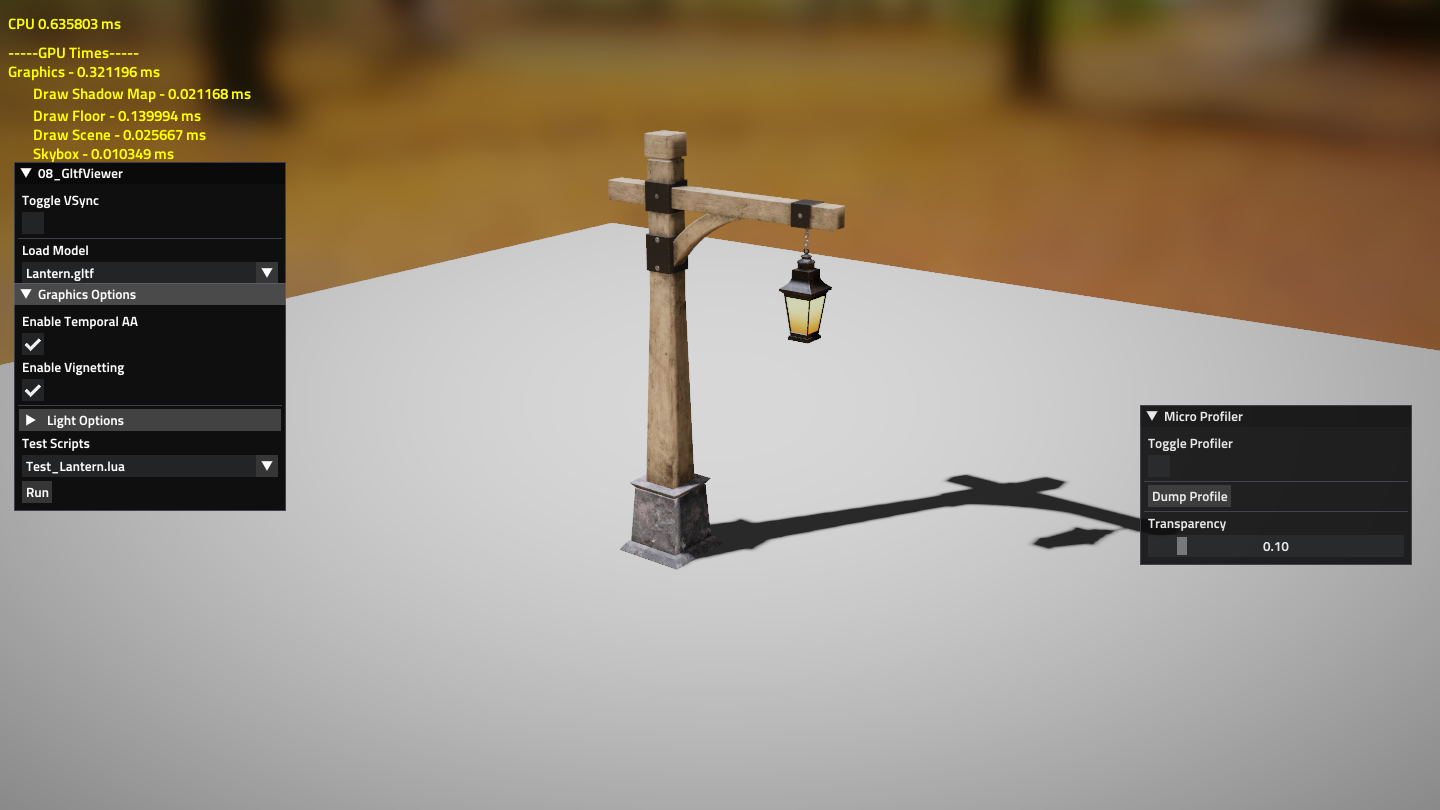
glTF Viewer running on Mac Mini M1

glTF Viewer running on XBOX One Original

9. Light and Shadow Playground
This unit test shows various shadow and lighting techniques that can be chosen from a drop down menu. There will be more in the future.
- Exponential Shadow Map - this is based on Marco Salvi's @marcosalvi papers. This technique filters out the edge of the shadow map by approximating the shadow test using exponential function that involves three subjects: the depth value rendered by the light source, the actual depth value that is being tested against, and the constant value defined by the user to control the softness of the shadow
- Adaptive Shadow Map with Parallax Correction Cache - this is based on the article "Parallax-Corrected Cached Shadow Maps" by Pavlo Turchyn in GPU Zen 2. It adaptively chooses which light source view to be used when rendering a shadow map based on a hiearchical grid structure. The grid structure is constantly updated depending on the user's point of view and it uses caching system that only renders uncovered part of the scene. The algorithm greatly reduce shadow aliasing that is normally found in traditional shadow map due to insufficient resolution. Pavlo Turchyn's paper from GPU Pro 2 added an additional improvement by implementing multi resolution filtering, a technique that approximates larger size PCF kernel using multiple mipmaps to achieve cheap soft shadow. He also describes how he integrated a Parallax Correction Cache to Adaptive Shadow Map, an algorithm that approximates moving sun's shadow on static scene without rendering tiles of shadow map every frame. The algorithm is generally used in an open world game to approximate the simulation of day & night’s shadow cycle more realistically without too much CPU/GPU cost.
- Signed Distance Field Soft Shadow - this is based on Daniel Wright's Siggraph 2015 @EpicShaders presentation. To achieve real time SDF shadow, we store the distance to the nearest surface for every unique Meshes to a 3D volume texture atlas. The Mesh SDF is generated offline using triangle ray tracing, and half precision float 3D volume texture atlas is accurate enough to represent 3D meshes with SDF. The current implementation only supports rigid meshes and uniform transformations (non-uniform scale is not supported). An approximate cone intersection can be achieved by measuring the closest distance of a passed ray to an occluder which gives us a cheap soft shadow when using SDF.
To achieve high-performance, the playground runs on our signature rendering architecture called Triangle Visibility Buffer. The step that generates the SDF data also uses this architecture.
Click on the following screenshot to see a movie:
The following PC screenshots are taken on Windows 10 with a AMD RX550 GPU (driver 19.7.1) with a resolution of 1920x1080.
Exponential Shadow Maps:
Adaptive Shadow Map with Parallax Correction Cache
Signed Distance Field Soft Shadow:
Signed Distance Field Soft Shadows - Debug Visualization
The following shots show Signed Distance Field Soft Shadows running on iMac with a AMD RADEON Pro 580
The following shots show Signed Distance Field Soft Shadows running on XBOX One:
Readme for Signed Distance Field Soft Shadow Maps:
To generate the SDF Mesh data you should select “Signed Distance Field” as the selected shadow type in the Light and Shadow Playground. There is a button called “Generate Missing SDF” and once its clicked, it shows a progress bar that represents the remaining SDF mesh objects utilized for SDF data generation. This process is multithreaded, so the user can still move around the scene while waiting for the SDF process to be finished. This is a long process and it could consume up to 8+ hours depending on your CPU specs. To check how many SDF objects there are presently in the scene, you can mark the checkbox "Visualize SDF Geometry On The Scene".
9a. Hybrid Ray-Traced Shadows
This unit test was build by Kostas Anagnostou @KostasAAA to show how to ray trace shadows without using a ray tracing API like DXR / RTX. It should run on all GPUs (not just NVIDIA RTX GPUs) and the expectation is that it should run comparable with a DXR / RTX based version even on a NVIDIA RTX GPU. That means the users of your game do not have to buy a NVIDIA RTX GPU to enjoy HRT shadows :-)

10. Screen-Space Reflections
This test offers two choices: you can pick either Pixel Projected Reflections or AMD's FX Stochastic Screen Space Reflection. We just made AMD's FX code cross-platform. It runs now on Windows, Linux, macOS, Switch, PS and XBOX.
Here are the screenshots of AMD's FX Stochastic Screen Space Reflections:
In case you pick Pixel-Projected Reflections, the application features an implementation of the papers Optimized pixel-projected reflections for planar reflectors and IMPLEMENTATION OF OPTIMIZED PIXEL-PROJECTED REFLECTIONS FOR PLANAR REFLECTORS
11. Multi-GPU (Driver support only on PC Windows)
This unit test shows a typical VR Multi-GPU configuration. One eye is rendered by one GPU and the other eye by the other one.
11a. Unlinked multiple GPUs (Driver support only on PC Windows)
For professional visualization applications, we now support unlinked multiple GPUs. A new renderer API is added to enumerate available GPUs. Renderer creation is extended to allow explicit GPU selection using the enumerated GPU list. Multiple Renderers can be created this way. The resource loader interface has been extended to support multiple Renderers. It is initialized with the list of all Renderers created. To select which Renderer (GPU) resources are loaded on, the NodeIndex used in linked GPU configurations is reused for the same purpose. Resources cannot be shared on multiple Renderers however, resources must be duplicated explicitly if needed. To retrieve generated content from one GPU to another (e.g. for presentation), a new resource loader operation is provided to schedule a transfer from a texture to a buffer. The target buffer should be mappable. This operation requires proper synchronization with the rendering work; a semaphore can be provided to the copy operation for that purpose. Available with Vulkan and D3D12. For other APIs, the enumeration API will not create a RendererContext which indicates lack of unlinked multi GPU support.
12. File System Test
This unit test showcases a cross-platform FileSystem C API, supporting disk-based files, memory streams, and files in zip archives. The API can be viewed in IFileSystem.h, and all of the example code has been updated to use the new API.
- The API is based around
Paths, where eachPathrepresents an absolute, canonical path string on a particular file system. You can query information about the files atPaths, open files asFileStreams, and copy files between differentPaths. - The concept of
FileSystemRoots has been replaced byResourceDirectorys.ResourceDirectorys are predefined directories where resources are expected to exist, and there are convenience functions to open files in resource directories. If your resources don’t exist within the default directory for a particular resource type, you can callfsSetPathForResourceDirectoryto relocate the resource directory; see the unit tests for sample code on how to do this.
14. Order-Independent Transparency
This unit test compares various Order-Indpendent Transparency Methods. In the moment it shows:
- Alpha blended transparency
- Weighted blended Order Independent Transparency Morgan McGuire Blog Entry 2014 and Morgan McGuire Blog Entry 2015
- Weighted blended Order Independent Transparency by Volition GDC 2018 Talk
- Adaptive Order Independent Transparency with Raster Order Views paper by Intel, supports DirectX 11, 12 only, and a Primer
- Phenomenological Transparency - Diffusion, Refraction, Shadows by Morgan McGuire

15. Wave Intrinsics
This unit test shows how to use the new wave intrinsics. Supporting Windows with DirectX 12 / Vulkan, Linux with Vulkan and macOS / iOS.
16. Path Tracer - Ray Tracing
The new 16_Raytracing unit test shows a simple cross-platform path tracer. On iOS this path tracer requires A11 or higher. It is meant to be used in tools in the future and doesn't run in real-time. To support the new path tracer, the Metal raytracing backend has been overhauled to use a sort-and-dispatch based approach, enabling efficient support for multiple hit groups and miss shaders. The most significant limitation for raytracing on Metal is that only tail recursion is supported, which can be worked around using larger per-ray payloads and splitting up shaders into sub-shaders after each TraceRay call; see the Metal shaders used for 16_Raytracing for an example on how this can be done.
macOS 1920x1080 AMD Pro Vega 64
iOS iPhone X 812x375
Windows 10 1080p NVIDIA RTX 2080 with DXR Driver version 441.12
Windows 10 1080p NVIDIA RTX 2080 with RTX Driver version 441.12
Linux 1080p NVIDIA RTX 2060 with RTX Driver version 435
17. Entity Component System Test
This unit test shows how to use the high-performance entity component system in The Forge.
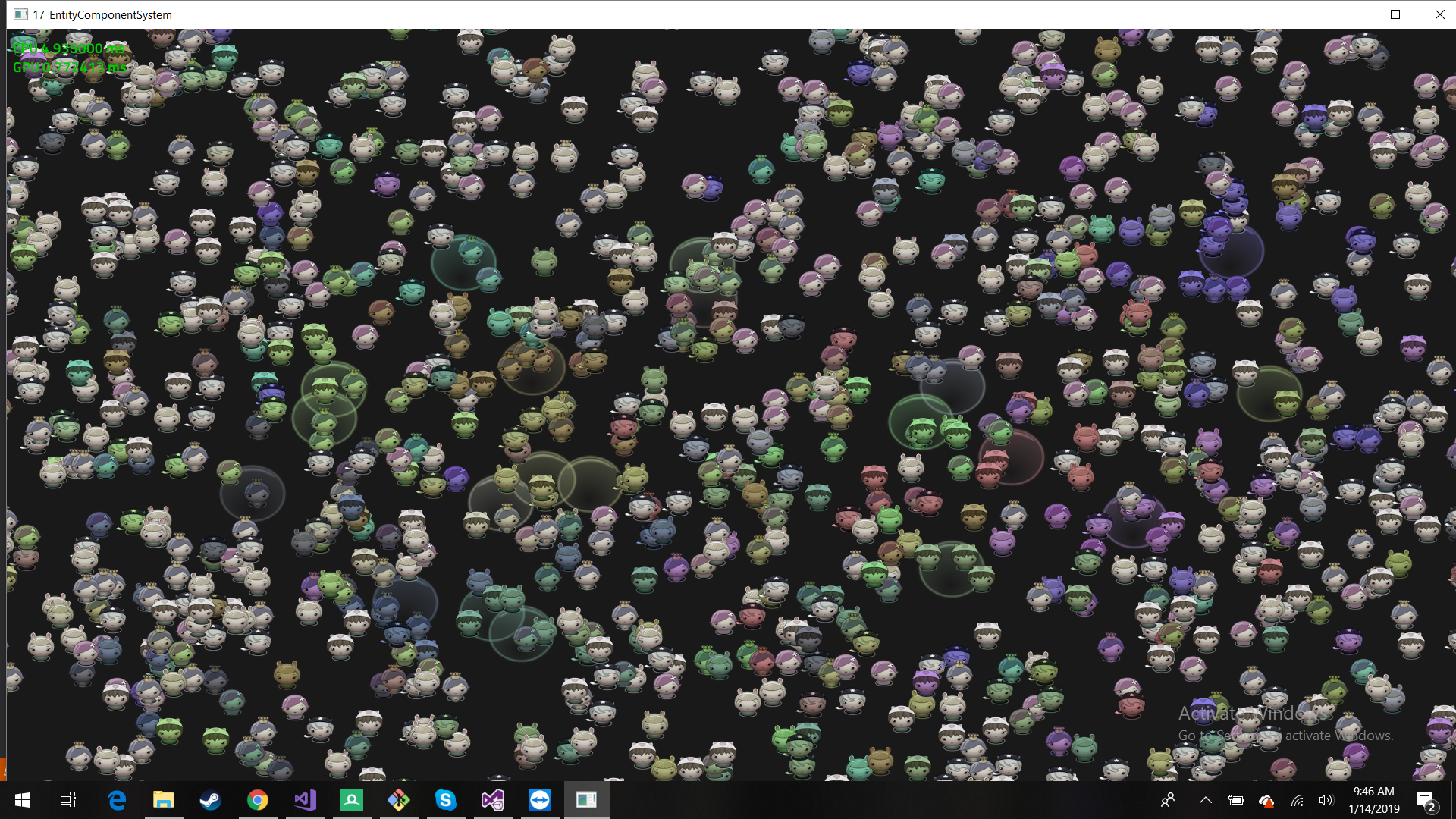
This unit test uses
Compared to our old ECS system our build times are now much better and the overall system runs faster:
CPU: intel i7-7700k
GPU: AMD Radeon RX570
Old ECS
Debug
Single Threaded: 90.0ms
Multi Threaded 29.0ms
Release:
Single Threaded: 5.7ms
Multi Threaded: 2.3ms
flecs
Debug
Single Threaded: 23.0ms
Multi Threaded 6.8ms
Release
Single Threaded 1.7ms
Multi Threaded 0.9ms
18. Sparse Virtual Textures
The Forge has now support for Sparse Virtual Textures on Windows and Linux with DirectX 12 / Vulkan. Sparse texture (also known as "virtual texture", “tiled texture”, or “mega-texture”) is a technique to load huge size (such as 16k x 16k or more) textures in GPU memory. It breaks an original texture down into small square or rectangular tiles to load only visible part of them.
The unit test 18_Virtual_Texture is using 7 sparse textures:
- Mercury: 8192 x 4096
- Venus: 8192 x 4096
- Earth: 8192 x 4096
- Moon: 16384 x 8192
- Mars: 8192 x 4096
- Jupiter: 4096 x 2048
- Saturn: 4096 x 4096
There is a unit test that shows a solar system where you can approach planets with Sparse Virtual Textures attached and the resolution of the texture will increase when you approach.
Linux 1080p NVIDIA RTX 2060 with RTX Driver version 435
Windows 10 1080p NVIDIA 1080 DirectX 12
Windows 10 1080p NVIDIA 1080 Vulkan
19. C Hot Reloading
This unit test showcases an implementation of code hot reloading in C, we've used and adapted the following GitHub library
for this.
The test contains two projects:
- 19_CodeHotReload_Main: generates the executable. All code in this project can't be hot-reloaded. This is the project you should set as startup project when running the program form an IDE.
- 19a_CodeHotReload_Game: for development platforms Windows/MacOS/Linux generates a dynamic library that is loaded by the Main project in runtime, when the dynamic library changes the Main program reloads the new code. For Android/IOS/Quest/Consoles this project is compiled and linked statically.
How to use it: While the Main project is running open 19_CodeHotReload_Game.cpp and perform some change, there are lines marked with TRY_CODE_RELOAD to make easy changes. Once the file is saved, you can rebuild the project and see the changes happen automatically.
- Windows/Linux: Click on the UI "RebuildGame" button.
- MacOS: Command+B on XCode to rebuild.
Note: In this implementation we can't call any functions from The Forge from the HotReloadable project (19a_CodeHotReload_Game), this is because we are compiling OS and Renderer as static libraries and linking them directly to the exe. Ideally these projects should be compiled as dynamic libraries in order to expose their functionality to the exe and hot reloadable dll. The reason we didn't implement it in this way is because all our other projects are already setup to use static libraries.
21. Ozz Playback Animation
This unit test shows how to playback a clip on a rig.
22. Ozz Playback Blending
This unit test shows how to blend multiple clips and play them back on a rig.
23. Ozz Joint Attachment
This unit test shows how to attach an object to a rig which is being posed by an animation.
24. Ozz Partial Blending
This unit test shows how to blend clips having each only effect a certain portion of joints.
25. Ozz Additive Blending
This unit test shows how to introduce an additive clip onto another clip and play the result on a rig.
26. Ozz Baked Physics
This unit test shows how to use a scene of a physics interaction that has been baked into an animation and play it back on a rig.
27. Ozz Multi Threading
This unit test shows how to animate multiple rigs simultaneously while using multi-threading for the animation updates.
28. Ozz Skinning
This unit test shows how to use skinning with Ozz
29. Ozz Inverse Kinematic
This unit test shows how to use a Aim and a Two bone IK solvers
33. YUV Support
YUV support: we have now YUV support for all our Vulkan API platforms PC, Linux, Android and Switch. There is a new functional test for YUV. It runs on all these platforms:
35. Variable Shading Rate
- Per tile Shading Rate Generating a shading rate lookup texture on-the-fly. Used for drawing the color palette which makes up the background. The rate decreases the further the pixels are located from the center. We can see artifacts becoming visible at aggressive rates, such as 4X4. There is also a slider in the UI to modify the center of the circle.
- Per-draw Shading Rate: The cubes are drawn by a different shading rate. They are following the Per-draw rate, which can be changed via the dropdown menu in the UI. By using a combiner that overrides the screen rates, we ensure that cubes are drawn by an independent rate.
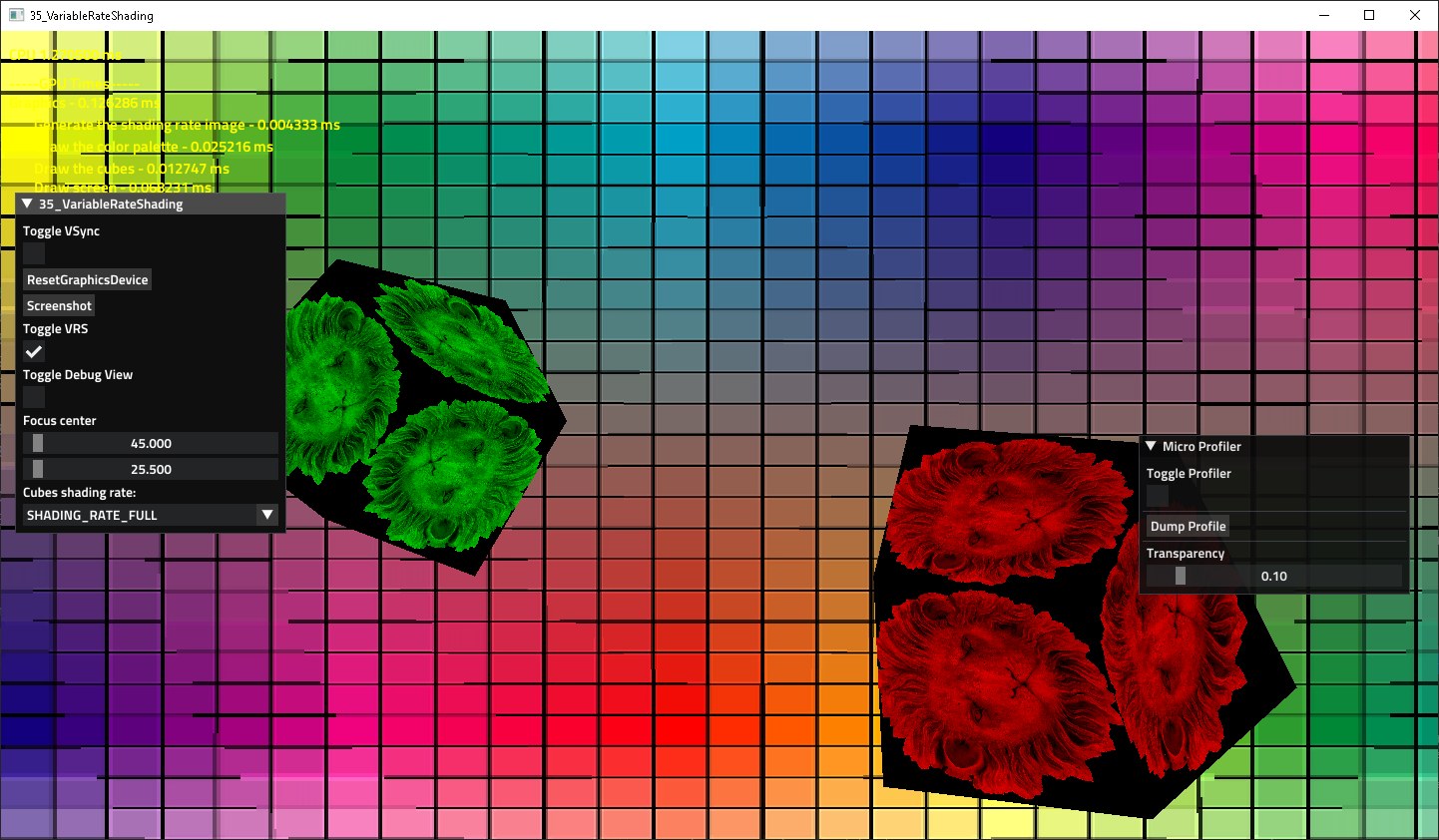 The cubes are using per-draw shading rate while the background is using per-tile shading rate.
The cubes are using per-draw shading rate while the background is using per-tile shading rate.
- Notes:
- There is a debug view showing the shading rates and the tiles' size.
- Per-tile method may not be available on certain GPUs even if they support the Per-draw method.
- The tile size is enforced by the GPU and is readable, as shown in the example.
- The shading rates available can vary based on the active GPU.
Examples
There is an example implementation of the Triangle Visibility Buffer as covered in various conference talks. Here is a blog entry that details the implementation in The Forge.
Tools
Below are screenshots and descriptions of some of the tools we integrated.
MTuner
MTuner MTuner was integrated into the Windows 10 runtime of The Forge following a request for more in-depth memory profiling capabilities by one of the developers we support. It has been adapted to work closely with our framework and its existing memory tracking capabilities to provide a complete picture of a given application’s memory usage.
To use The Forge’s MTuner functionality, simply drag and drop the .MTuner file generated alongside your application’s executable into the MTuner host app, and you can immediately begin analyzing your program’s memory usage. The intuitive interface and exhaustive supply of allocation info contained in a single capture file makes it easy to identify usage patterns and hotspots, as well as tracking memory leaks down to the file and line number. The full documentation of MTuner can be found [here](link: https://milostosic.github.io/MTuner/).
Currently, this feature is only available on Windows 10, but support for additional platforms provided by The Forge is forthcoming.
Here is a screenshot of an example capture done on our first Unit Test, 01_Transformations:

Ray Tracing Benchmark
Based on request we are providing a Ray Tracing Benchmark in 16_RayTracing. It allows you to compare the performance of three platforms:
- Windows with DirectX 12 DXR
- Windows with Vulkan RTX
- Linux with Vulkan RTX
We will extend this benchmark to the non-public platforms we support to compare the PC performance with console performance. The benchmark comes with batch files for all three platforms. Each run generates a HTML output file from the profiler that is integrated in TF. The default number of iterations is 64 but you can adjust that. There is a Readme file in the 16_RayTracing folder that describes the options.
Windows DirectX 12 DXR, GeForce RTX 2070 Super, 3840x1600, NVIDIA Driver 441.99
Windows Vulkan RTX, GeForce RTX 2070 Super, 3840x1600, NVIDIA Driver 441.99
Microprofiler
We integrated the Micro Profiler into our code base by replacing the proprietary UI with imGUI and simplified the usage. Now it is much more tightly and consistently integrated in our code base.
Here are screenshots of the Microprofiler running the Visibility Buffer on PC:
Here are screenshots of the Microprofiler running a unit test on iOS:
Check out the Wikipage for an explanation on how to use it.
Shader Translator
We provide a shader translator, that translates one shader language -a superset of HLSL called Forge Shader Language (FLS) - to the target shader language of all our target platforms. That includes the console and mobile platforms as well. It is written in Python. We expect this shader translator to be an easier to maintain solution for smaller game teams because it allows to add additional data to the shader source file with less effort. Such data could be for example a bucket classification or different shaders for different capability levels of the underlying platform, descriptor memory requirements or resource memory requirements in general, material info or just information to easier pre-compile pipelines. The actual shader compilation will be done by the native compiler of the target platform.
How to use the Shader Translator
Releases / Maintenance
The Forge Interactive Inc. will prepare releases when all the platforms are stable and running and push them to this GitHub repository. Up until a release, development will happen on internal servers. This is to sync up the console, mobile, macOS and PC versions of the source code.
Products
We would appreciate it if you could send us a link in case your product uses The Forge. Here are the ones we received so far or we contributed to:
BuildBox
The game engine BuildBox is now using The Forge (click on image to go to the Steam Store):
Lethis
The Game "Lethis Path of Progress" is now using The Forge (click on image to go to the Steam Store)
Supergiant Games Hades
Supergiant's Hades we are working with Supergiant since 2014. One of the on-going challenges was that their run-time was written in C#. At the beginning of last year, we suggested to help them in building a new cross-platform game engine in C/C++ from scratch with The Forge. The project started in April 2019 and the first version of this new engine launched in May this year. Hades was then released for Microsoft Windows, macOS, and Nintendo Switch on September 17, 2020. The game can run on all platforms supported by The Forge.
Here is a screenshot of Hades running on Switch:
Here is an article by Forbes about Hades being at the top of the Nintendo Switch Charts. Hades is also a technology showcase for Intel's integrated GPUs on macOS and Windows. The target group of the game seems to often own those GPUs.
Bethesda's Creation Engine
Bethesda based their rendering layer for their next-gen engine on The Forge. We helped integrate and optimize it.
Here is more info about this game engine:
Todd Howard Teases Bethesda's New Game Engine Behind The Elder Scrolls 6 And Starfield
Bethesda's overhauling its engine for Starfield and The Elder Scrolls 6
M²H - Stroke Therapy
M²H uses The Forge - M²H is a medical technology company. They have developed a physics-based video game therapy solution that is backed by leading edge neuroscience, powered by Artificial Intelligence and controlled by dynamic movement – all working in concert to stimulate vast improvement of cognitive and motor functions for patients with stroke and the aged. The Forge provides the rendering layer for their application. Here is a YouTube video on what they do:
StarVR One SDK
The Forge is used to build the StarVR One SDK:
Torque 3D
The Forge will be used as the rendering framework in Torque 3D:
Star Wars Galaxies Level Editor
SWB is an editor for the 2003 game 'Star Wars Galaxies' that can edit terrains, scenes, particles and import/export models via FBX. The editor uses an engine called 'atlas' that will be made open source in the future. It focuses on making efficient use of the new graphics APIs (with help from The-Forge!), ease-of-use and terrain rendering.
Writing Guidelines
For contributions to The Forge we apply the following writing guidelines:
- We limit all code to C++ 11 by setting the Clang and other compiler flags
- We follow the [Orthodox C++ guidelines] (https://gist.github.com/bkaradzic/2e39896bc7d8c34e042b) minus C++ 14 support (see above)
- Please note that we are going to move towards C99 usage more and more because this language makes it easier to develop high-performance applications in a team. With the increased call numbers of modern APIs and the always performance-detoriating C++ features, C++ is becoming more and more a productivity and run-time performance challenge. C is also a better starting point to port to other languages like RUST. In case any of those languages become common in development.
User Group Meetings
There will be a user group meeting during GDC. In case you want to organize a user group meeting in your country / town at any other point in time, we would like to support this. We could send an engineer for a talk.
Support for Education
In case your School / College / University uses The Forge for education, we would like to support this as well. We could send an engineer or help create material. So far the following schools use The Forge for teaching:
Breda University of Applied Sciences
Contact:
Jeremiah van Oosten
Monseigneur Hopmansstraat 1
4817 JT Breda
Contact:
Andrew Hogue
Ontario Tech University
SIRC 4th floor
2000 Simcoe St N
Oshawa, ON, L1H 7K4
Open-Source Libraries
The Forge utilizes the following Open-Source libraries:
- Fontstash
- Vectormath
- Nothings single file libs
- shaderc
- SPIRV_Cross
- TinyEXR
- Vulkan Memory Allocator
- D3D12 Memory Allocator
- GeometryFX
- WinPixEventRuntime
- Fluid Studios Memory Manager
- volk Metaloader for Vulkan
- gainput
- Dear ImGui
- DirectX Shader Compiler
- Ozz Animation System
- Lua Scripting System
- TressFX
- Micro Profiler
- MTuner
- EASTL
- meshoptimizer
- Basis Universal Texture Support
- TinyImageFormat
- minizip ng
- flecs
- Android Vulkan Validation Layers
- CPU Features
- HIDAPI
- cf
- bstrlib
- stb_ds
- cr





